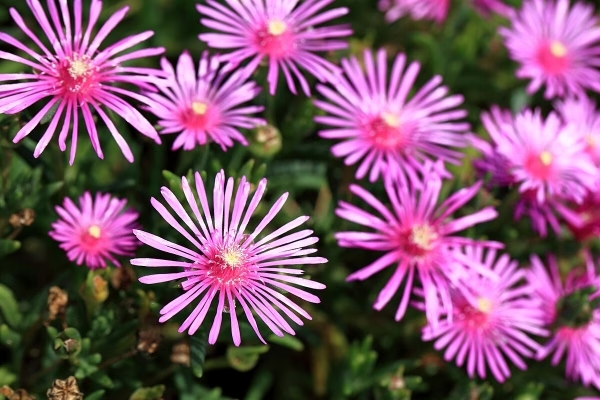
Ice Plant
Botanical Name
:
Delosperma cooperi
Plant Type
:
Succulent perennial ground cover
Seasons
:
Year-round; active growth and flowering from early summer to fall
Sun Level
:
Full sun with at least 6 hours of direct sunlight per day.
Soil Type
:
Well-draining sandy or shallow rocky soils. Avoid heavy clay or poorly draining soils
Germination
:
Propagates easily from seeds, cuttings, or division. Seeds germinate in 14–21 days
P.H. Level
:
Slightly acidic to neutral (6.0–7.5)
Water/Irrigation
:
Drought-resistant, only water when the soil is completely dry
Fertilization
:
Minimal. Apply a diluted, balanced fertilizer in early spring if needed
Habit
:
Forms a dense mat of fleshy leaves on spreading stems
Final Plant Height
:
2–6 inches (5–15 cm)
Spread
:
12–36 inches (30–90 cm)
Spacing
:
12–18 inches apart for full coverage
Flowers
:
Daisy-like, vibrant purple, pink, yellow, orange, or white blooms from late spring to fall
Attracts
:
Bees, butterflies, and pollinators
Uses
:
Rock gardens, ground cover, erosion control, xeriscaping, borders, containers
Companions
:
Sedum, lavender, yarrow, agave, yucca, ornamental grasses
Pruning
:
Trim back dead growth in early spring to encourage fresh growth
Toxicity
:
Non-toxic to humans and pets
Pests
:
Generally pest-free but may attract aphids or mealybugs
Diseases
:
Root rot if overwatered; occasional fungal issues in humid conditions
Fun Fact
:
Ice Plants get their name from their shimmering, reflective leaf surfaces that look like ice crystals under sunlight
Additional Info
:
Ice Plants are excellent for erosion control, as their dense mat-like growth stabilizes soil on slopes and rocky areas
Botanical Name
:
Delosperma cooperi
Plant Type
:
Succulent perennial ground cover
Seasons
:
Year-round; active growth and flowering from early summer to fall
Sun Level
:
Full sun with at least 6 hours of direct sunlight per day.
Soil Type
:
Well-draining sandy or shallow rocky soils. Avoid heavy clay or poorly draining soils
Germination
:
Propagates easily from seeds, cuttings, or division. Seeds germinate in 14–21 days
P.H. Level
:
Slightly acidic to neutral (6.0–7.5)
Water/Irrigation
:
Drought-resistant, only water when the soil is completely dry
Fertilization
:
Minimal. Apply a diluted, balanced fertilizer in early spring if needed
Habit
:
Forms a dense mat of fleshy leaves on spreading stems
Final Plant Height
:
2–6 inches (5–15 cm)
Spread
:
12–36 inches (30–90 cm)
Spacing
:
12–18 inches apart for full coverage
Flowers
:
Daisy-like, vibrant purple, pink, yellow, orange, or white blooms from late spring to fall
Attracts
:
Bees, butterflies, and pollinators
Uses
:
Rock gardens, ground cover, erosion control, xeriscaping, borders, containers
Companions
:
Sedum, lavender, yarrow, agave, yucca, ornamental grasses
Pruning
:
Trim back dead growth in early spring to encourage fresh growth
Toxicity
:
Non-toxic to humans and pets
Pests
:
Generally pest-free but may attract aphids or mealybugs
Diseases
:
Root rot if overwatered; occasional fungal issues in humid conditions
Fun Fact
:
Ice Plants get their name from their shimmering, reflective leaf surfaces that look like ice crystals under sunlight
Additional Info
:
Ice Plants are excellent for erosion control, as their dense mat-like growth stabilizes soil on slopes and rocky areas
Written by Salome Wapukha – https://www.linkedin.com/in/salome-wapukha-556700193/

